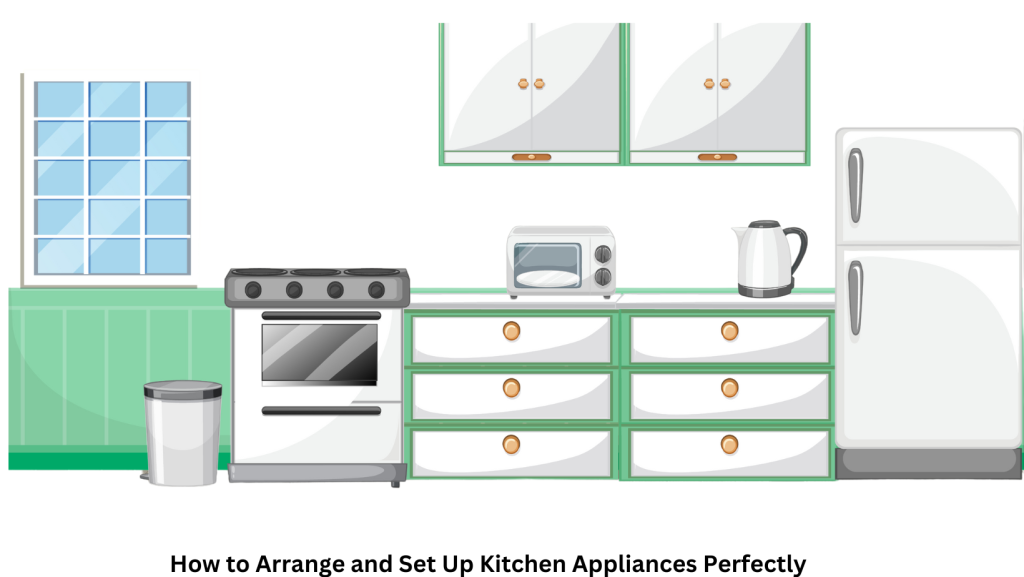Have you ever felt overwhelmed by the thought of setting up your kitchen appliances? Whether you’re moving into a new home or simply upgrading your space, figuring out where everything goes can feel like a challenge.
The truth is, a well-organized kitchen can make all the difference in your cooking and daily routine. But with so many appliances to consider—fridges, ovens, dishwashers, and more—it’s easy to get confused about how to place and set them up effectively.
How to Properly Set Up Your Kitchen
Setting up your kitchen the right way can make cooking and cleaning easier and more enjoyable. Here’s a simple step-by-step guide to help you get started.
- Evaluate the Kitchen Space
Start by looking at your kitchen layout. Measure the available space and think about where each appliance will fit best. Consider things like traffic flow and how much room you need to move around. Make sure there’s enough space for larger items like your fridge, stove, and dishwasher. - Create Zones
Divide your kitchen into different zones based on the tasks you’ll be doing. For example, the cooking zone should be close to the stove, oven, and microwave. The cleaning zone should have the sink, dishwasher, and trash. The food storage zone is where your fridge, pantry, and cabinets should go. Organizing appliances into these zones will make your kitchen more efficient. - Consider Accessibility
Think about which appliances you use most often and place them in easily accessible spots. For instance, keep your coffee maker or toaster near the counter where you prep breakfast. Appliances that you use less often, like a slow cooker, can be placed further away in cabinets or on shelves. - Ensure Proper Installation
Make sure that appliances are properly installed. Some require plumbing, like your dishwasher or fridge with an ice maker. Others need special electrical connections, like an oven or microwave. Always follow the manufacturer’s instructions and, if needed, hire a professional to make sure everything is set up safely.

Do Your Kitchen Appliances Have to Match?
When it comes to setting up your kitchen, one of the big decisions is whether or not your appliances should match. There are both pros and cons to consider, so let’s break them down.
Aesthetics
One of the main reasons people choose matching appliances is for the look. Having all your appliances in the same style, color, and brand can give your kitchen a clean, cohesive feel. If you like a sleek, uniform design, matching appliances can create a more stylish and polished look.
Functionality
However, matching appliances may not always be the best choice when it comes to functionality. Different brands can offer unique features that make one appliance better for your needs than another. For example, one brand may have a fridge with better storage options, while another might have an oven with advanced cooking settings. In this case, mixing and matching can provide more useful features, even if it means sacrificing a perfect visual match.
Is Matching Necessary?
Matching appliances aren’t a must. It depends on your kitchen style and personal preferences. If you prioritize looks and want a modern, streamlined feel, go for matching appliances. If you’re more focused on finding the best features and functionality for each appliance, it’s okay to mix brands. It all comes down to what works best for your needs and your kitchen space.
Do Your Kitchen Appliances Have to Be the Same Brand?
Choosing appliances for your kitchen often raises a common question: Should they all be from the same brand? While some people prefer brand consistency, others mix and match to suit their needs. Let’s explore the advantages and disadvantages of sticking with one brand.
Advantages of the Same Brand
One big advantage of choosing appliances from the same brand is easier maintenance. If something goes wrong, you can contact the same company for service or repairs, which saves time and hassle. Additionally, many brands design their appliances to work seamlessly together, especially when it comes to smart features. For example, a smart oven and smart fridge from the same brand might connect to a single app, making them easier to control.
Disadvantages of Sticking to One Brand
However, sticking to one brand might limit your options. Not all brands excel in every type of appliance. For instance, one brand may make excellent refrigerators but average dishwashers. By mixing brands, you can choose the best product for each category, often saving money or gaining better performance.
When Mixing Brands Makes Sense
Mixing brands can be a great choice if you’re looking for specific features or have a budget to stick to. It’s also a good idea if aesthetics aren’t your top priority or if you’re open to customizing the look of your kitchen with a variety of designs. Just make sure to choose appliances that complement each other in style and finish.
Ultimately, there’s no one-size-fits-all answer. If you value convenience and brand-specific integration, sticking to the same brand makes sense. But if performance and variety are more important, mixing brands might be the better option. The key is to find what works best for your lifestyle and your kitchen.
How to Store Your Kitchen Appliances
Properly storing your kitchen appliances can make your space more organized and functional. Here’s how to organize both large and small appliances efficiently.
Countertop Storage
Some appliances are used daily and should be kept on the countertop for convenience. Items like coffee makers, toasters, and electric kettles are great examples. They’re easy to access and save you from constantly pulling them in and out of storage. Just make sure to keep these appliances in a designated area to avoid a cluttered look.
Cabinet Storage
For appliances you use less frequently, like blenders, food processors, or stand mixers, cabinets are the perfect place. Store these items in lower cabinets to free up counter space, but keep them in spots that are easy to reach when needed. Using labeled bins or pull-out trays can make accessing these appliances even easier.
Vertical Storage
If you’re short on counter or cabinet space, consider vertical storage options. Wall-mounted racks, floating shelves, or tall pantry shelves can help you store smaller appliances without taking up floor or counter space. For example, you can use a shelf to hold a small microwave or toaster oven while keeping the countertop clear.
Ventilation Needs
Not all appliances can be stored inside closed cabinets. Appliances like microwaves and toaster ovens need proper ventilation to avoid overheating. If you plan to store these in a cabinet, make sure there is enough airflow or use cabinets designed for built-in appliances.
By organizing your appliances based on usage and storage requirements, you can create a neat and functional kitchen space. Keep your most-used appliances accessible and your less-used ones tucked away to maintain a clean and efficient setup.

How to Update Old Kitchen Appliances
Updating your old kitchen appliances can be a smart way to save money and improve your kitchen’s functionality. Here’s how to decide whether to upgrade or replace, along with tips for making cost-effective updates.
Upgrade vs. Replace
Deciding whether to upgrade or replace depends on the condition and performance of your appliance. If your appliance still works but feels outdated, upgrading might be the better choice. For example, adding smart features like plug-in smart outlets can modernize older devices. Replacing parts like water filters or seals can also extend the lifespan of appliances like refrigerators or dishwashers.
However, if the appliance is too old, inefficient, or frequently breaks down, it might be time for a replacement. Newer models often come with energy-saving features and advanced technology, making them worth the investment in the long run.
Tips for Upgrading Appliances
Enhancing old appliances doesn’t always require a full replacement. Regular cleaning can improve efficiency, such as removing lint from dryers or cleaning the coils of your refrigerator. Replacing worn-out parts like knobs, trays, or filters can make your appliance feel like new. You can also add smart home integrations, such as smart plugs or voice-controlled devices, to give your older appliances modern features.
Cost-Effective Updates
If you’re on a budget, there are simple ways to improve your appliances without spending a lot. For example:
- Replace an outdated light in your microwave or fridge.
- Use appliance paint to refresh the look of a worn-out surface.
- Install smart plugs to control appliances remotely.
These small updates can help your kitchen feel modern without the cost of buying new appliances.
By knowing when to upgrade and when to replace, you can keep your kitchen running smoothly and save money at the same time. With a few simple updates, even older appliances can get a fresh start.
Additional Considerations for Kitchen Appliance Setup
Setting up your kitchen appliances is about more than just placement—it’s also about efficiency, smart integrations, and safety. Here are some key considerations to keep in mind.
Energy Efficiency
Choosing energy-efficient appliances can help reduce your electricity bills and your carbon footprint. Look for models with an ENERGY STAR rating, which ensures they use less power without sacrificing performance. Arrange appliances to optimize energy use. For example, keep your refrigerator away from heat sources like ovens or sunlight, as excess heat makes it work harder. Also, use small appliances like toaster ovens or air fryers for quick tasks instead of heating a large oven.
Smart Appliances
Integrating smart appliances into your kitchen can make life easier. Smart refrigerators can manage grocery lists, while smart ovens let you control cooking times remotely. Dishwashers with smart features can be programmed to run during off-peak energy hours. When setting up smart appliances, ensure they connect smoothly to your home Wi-Fi and are compatible with your existing smart home system. Position them in areas with a strong network signal for uninterrupted functionality.
Safety
Safety should always be a priority when setting up appliances. Make sure outlets are grounded and can handle the power needs of large appliances. Avoid overloading circuits, which can lead to electrical fires. Leave enough space around appliances like microwaves and toaster ovens for ventilation to prevent overheating. Keep cords organized and away from water sources to avoid accidents.
Conclusion
Setting up your kitchen requires more than just arranging appliances. It involves thoughtful planning, balancing functionality with aesthetics, and keeping everything well-maintained. By carefully placing your appliances in accessible and efficient spots, you can create a space that makes cooking and cleaning easier.
Don’t forget to consider your kitchen’s layout, energy needs, and personal preferences when deciding on upgrades or replacements. Whether you’re incorporating smart appliances or making small updates to older ones, each choice can improve your kitchen’s efficiency and style.
Smart Strategies for a Functional Kitchen Setup
Add a personal touch to inspire readers. Share stories about real-life kitchen makeovers or examples of how others organize their appliances. For instance, explain how someone transformed a cluttered kitchen into a sleek, efficient space. These examples spark ideas and make the tips relatable.
Visual aids are powerful. Show diagrams of smart appliance layouts or photos of kitchens with different brands working together. Images make it easier to visualize and plan your own space.
Answer common questions to clear doubts. Can you mix appliance brands? Yes, but focus on matching finishes and styles for a cohesive look. How do you store appliances effectively? Keep items you use daily on countertops and store less-used ones in cabinets or pantries. This approach saves space and keeps your kitchen tidy.

I’m a writer and culinary expert with over 10 years of experience in the kitchen. As a graduate of the Institute of Culinary Education and a passionate home chef, I created KitchenBreez.com to share my knowledge of kitchen techniques, cooking tips, and the best kitchen gadgets. Whether you’re a seasoned cook or just starting, my goal is to help you make your time in the kitchen more efficient and enjoyable.
